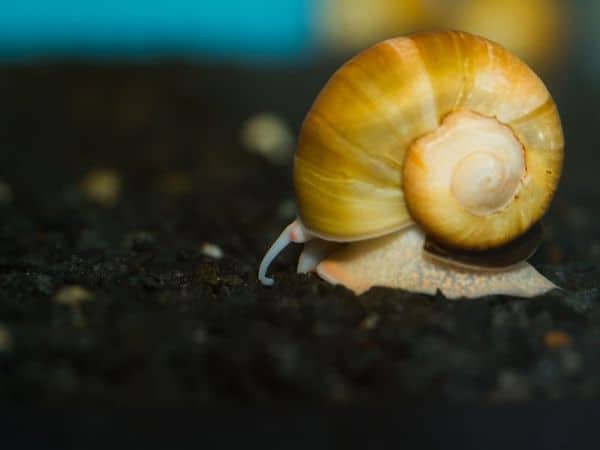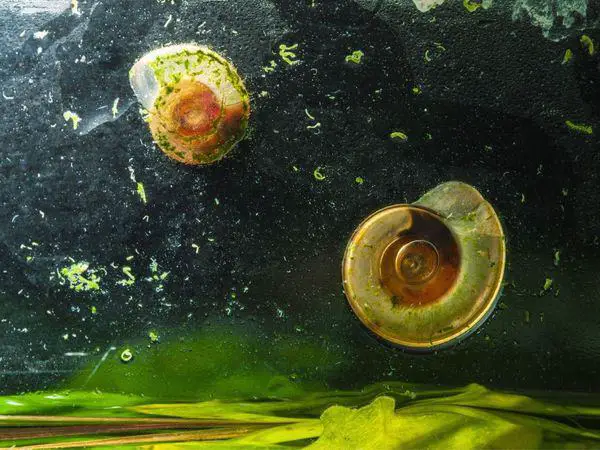The apple snail (Ampullariidae) is a family of aquatic freshwater snails or gastropod mollusks with an operculum and a gill. They are the superfamily in the family of Ampullarioidea, since they have both lungs and gills, with a mantle cavity subdivided to separate the two types of respiratory systems. This variation makes apple snails amphibious.
Unlike some other snails, this family is known to be gonochoristic. This means that you need both female and male snails in order to breed.

So, are apple snails good or bad? Apple snails are good if they are kept in their natural habitat and consumed as a source of food and are bad if they are introduced to vegetation areas and non-native regions.
As stated earlier, Apple snails are amphibious so, they can thrive in both regions of high rainfall and drought. Their ability to thrive well during dry periods is attributed to the operculum that enables them to seal their shell entrance.
This prevents the apple snails from drying out during dry periods when they are underground, buried in the mud.
As you read further, you will get to understand more about the peculiarities of these apple snails in terms of their adaptation, habitat, importance, and so much more.
On another note, you can check out the profitability of snail farming (land and aquatic) in the USA  and Canada
and Canada  to learn more about the challenges and opportunities of this business.
to learn more about the challenges and opportunities of this business.
Adaptation
One of the typical adaptations of apple snails (Ampullariidae) is bronchial respiration. They have lungs and gills on the right side of their body that help them breathe both on land and underwater. The gills and lungs combination expands their action radius in search of food.
So, they can come out of the water to source food on land in situations where food and water might not be enough for their well-being.
Several species of apple snail (Asolene/Pomella, Pomacea, and Pila) deposit eggs in calcareous clutches above the waterline, usually recognized by their light pink color. This strategy protects their eggs from predators such as fish and other aquatic inhabitants.

Another remarkable anti-predator adaptation of the Pila and Pomacea apple snail species is the tubular siphon, that they use to breathe while submerged, reducing exposure to attacking birds. The main enemies to apple snails are snail kites and birds limpkin.
Habitat
Apple snails are found in various ecosystems: rivers, swamps, and ponds. They spend their good time underwater, in as much as they occasionally leave water in search of food.
Reproduction
Reproduction in apple snails occurs mostly the warm periods. The snails are hermaphrodites but still require the presence of two snails taking up the different sexes for mating to be possible. They are known as gonochoristic. When they lay their eggs, they do so at night on stable objects located mostly above the water.
The eggs laid are usually pink, but as they hatch, they begin to whiten then the newborn apple snails crawl out of the egg clusters into the water immediately. Laying their eggs is a form of adaptation for these snails. They do so to prevent their eggs from being preyed upon and expose the eggs to better oxygen. (Source )
)
If you are curious to find out how the other snail species mate and reproduce, you should have a look at this article – Snails reproduction: How do snails reproduce?
Can an apple snail be kept as a pet?
Yes, the apple snails can be kept as pets as they are common aquarium animals due to their size and attractive appearance. When you take care of these species properly, some can grow as big as 15 cm (5.9 in) diameter. The apple snails include species that have proved to be the biggest fresh aquatic snails on earth.
The most popular apple snail available in aquarium shops includes Pomacea diffusa and Pomocea bridgesii (both referred to as spike-topped apple snails or mystery snails). These apple snail species come in a vast range of colors from brown to yellow or albino and even pink, jade, blue, and purple.
Another common species of apple snails is the Pomacea canalicuta. They are rounder, bigger, and will often feed on aquatic plants, which makes them less suitable for most aquariums. Occasionally, you will find the Pomocea paludosa (Florida apple snail) in the aquarium trade and are often found in ponds and ditches as wild snails.

The recommended optimal aquarium water temperature for these snails is between 18 and 28 degrees Celsius. Apple snails are livelier and more active in the higher temperature range regions, where they tend to crawl, eat, and grow faster. The snails may become less active at a lower temperature range.
Apple snails come in different body and shell colors. The body of these apple snails shows a significant variation from yellow to black and gray. Another popular giant apple snail known as Pomocea Canalicuta is rounder and bigger. This makes it less suitable for most freshwater.
Apple snails are mostly sold as ‘’golden (blue, black ivory) mystery snail’’ names and are given incorrect species names such as Ampullarius instead of Pomocea.
Is it illegal to keep an apple snail as a pet?
Since the year 2000, there have been restrictions enforced across the world regarding the Apple snail trade. Most Apple snail species have proved devastating and destructive when released out to the wild.
Unfortunately, some people still release these creatures to the outside world, forcing governments to impose a ban on trade and even ban possession completely. Most of the apple snails existing today are not easily visible through pet shops for this reason.
Tip: You may also refer to our African Snail as a Pet article.
article.
Importance of the apple snails
Apple snails as a bio-control agent
Some apple snail species such as Marisa and Pomacea species were introduced to Asia and Africa for the control of other medically dangerous snails like the Biomphalaria and Bulinus species. These apple snails have proved to serve as intermediate hosts to human health parasites like trematode parasites.
These dangerous parasites can cause schistosomiasis and swimmers itch diseases that affect millions of people across tropical regions. One of the bio-agent snail species is the Marisa cornuarietis, which directly preys on other snail species and also competes with other species.
Apple snails as a human delicacy
In Mexico and Veracruz, there are some subspecies of apple snails locally known as tegogolo common in Lake Catemaco. These snails are known as nutritious delicacies for human consumption.
They contain about 12 grams of protein content per 100 grams of apple snails according to the apple snail nutritional information. (Source ) Apple snails are also high in minerals and low in fat. Note that, Only specifically cultured or wild snails are fit for human consumption. Those in domestic Aquarian may not be suitable for human consumption.
) Apple snails are also high in minerals and low in fat. Note that, Only specifically cultured or wild snails are fit for human consumption. Those in domestic Aquarian may not be suitable for human consumption.
Find out more about the nutritional benefits of snail consumption from our article on “Is eating snail healthy?”
Conclusion
The latest spread of apple snails across the globe and their capability of becoming pests shows the dangers of introducing these non-native species. The invasive culture of these species explains the reason why most countries have put strict measures and policies when it comes to handling and importing foreign animals such as apple snails.
Always ensure you do not release apple snails in rivers or local ponds unless approved by the regulating bodies.
